One of the most important things to know about a boat is the size of the gas (fuel) tank. Of course, gas tank sizes can differ between brand and model. In this article, we will walk you through the fuel capacities of different boat models in a detailed way with examples.
On average, a boat can hold around 40 gallons of gas in its fuel tank. But the range can vary from as small as 5 gallons or less for a small boat to as big as 250,000 gallons or more for a big yacht. Yet, most brands allow buyers to customize the boat accordingly, worrying less about fuel volumes.
Boats are not as fuel-efficient as cars. They consume a lot of gas compared to other vehicles due to their traversing in the waters. That’s the main reason why boats have bigger fuel tanks compared to other land-moving vehicles.
Many small boats tend to use 3-8 gallons of gas per hour at cruising speeds, while faster boats like speed and motorboats can use 25-40 gallons an hour. Depending on the boat’s weight, design, and, very importantly, the type of motor it has, the fuel burning rate changes drastically.
An older boat with an older engine will have poor fuel mileage when compared to more modern boats. Here’s a table showing the sizes of different boat models and their average fuel capacities range.
| Boat Model | Fuel Capacity Range |
| Speedboat | 150 – 1000 Gallons |
| Pontoon Boat | 10 – 60 Gallons |
| Bass Boat | 20 – 70 Gallons |
| Cabin Cruisers | 200 – 500 Gallons |
| Cuddy Cabin | 30 – 150 Gallons |
| Yacht | 1,000 – 350,000 |
Those are the average fuel capacities for different boat models. OKAY, without further ado, let’s see the fuel capacities of those different boats in a detailed way.
Related post – What Fuel Do Boats Use? Check this article to know the types of fuels used in boats and their advantages & drawbacks in a detailed way.
How Many Gallons Of Gas Does A Speedboat Hold?
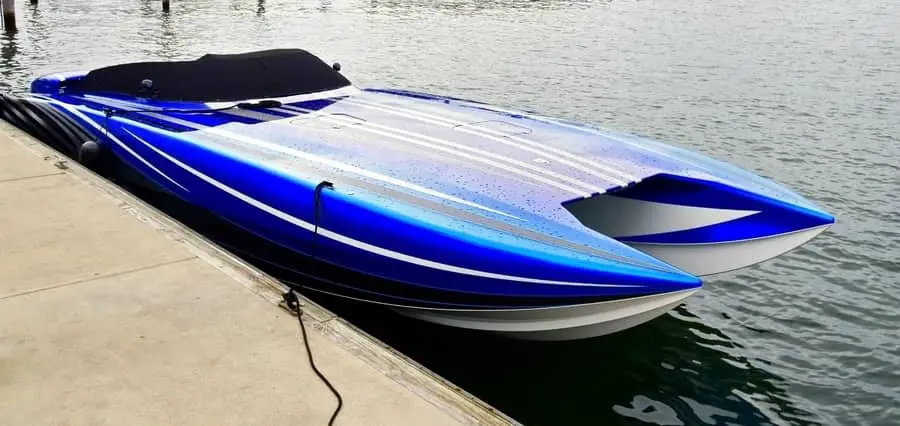
On average, a speedboat can hold around 250 gallons of gas in its fuel tank. But the range can vary from 150 gallons or less for a small speedboat to 1,000 gallons or more for a big speedboat. Yet, most brands allow buyers to customize the boat to their needs, worrying less about fuel capacities.
Those values may sound very big compared to other boats, but at their burning rate (which is, by the way, around 25 – 40 gallons an hour), they are comparable with normal boats with smaller tanks. Here’s a table showing the fuel capacities of different speedboat models.
| Speedboat Model | Fuel Capacity |
| Skater 28 | 140 Gallons |
| Midnight Express 34 Open | 300 Gallons |
| Mystic M3800 | 293 Gallons |
| Cigarette 42 Auroris | 470 Gallons |
| Midnight Express 43 Open | 450 Gallons |
| Skater 46 | 500 Gallons |
| MTI V-50 | 550 Gallons |
| Cigarette 515 | 278 Gallons |
| Cigarette 59 Tirranna | 1000 Gallons |
| Midnight Express 60′ Pied-A-Mer | 1000 Gallons |
A speedboat can cost around $350,000 on average. But depending on the model, amenities, speed, and the make you are looking for, the price may vary from as low as $100,000 or low to as high as $4,000,000 or more. Also, the price drastically depends on the “BRAND” rather than just the “SPEED.”
High-performance boats, also known as go-fast boats, racing boats, cigarette boats, powerboats, etc., are speedboats used in racing, recreational, luxury, law enforcement, and many other applications. By conventional standards, a high-performance boat is one that tops 60 mph.
But many of the speedboats in the market today easily hit 80+ mph. At that speed, the fuel burns very quickly. That’s why most of the speedboats have very big tanks compared to other small boats.
Related post – How Much Does A Speedboat Cost? Check this article to know the average costs of a speed boat with 15 examples in a detailed way.
How Many Gallons Of Gas Does A Pontoon Boat Hold?
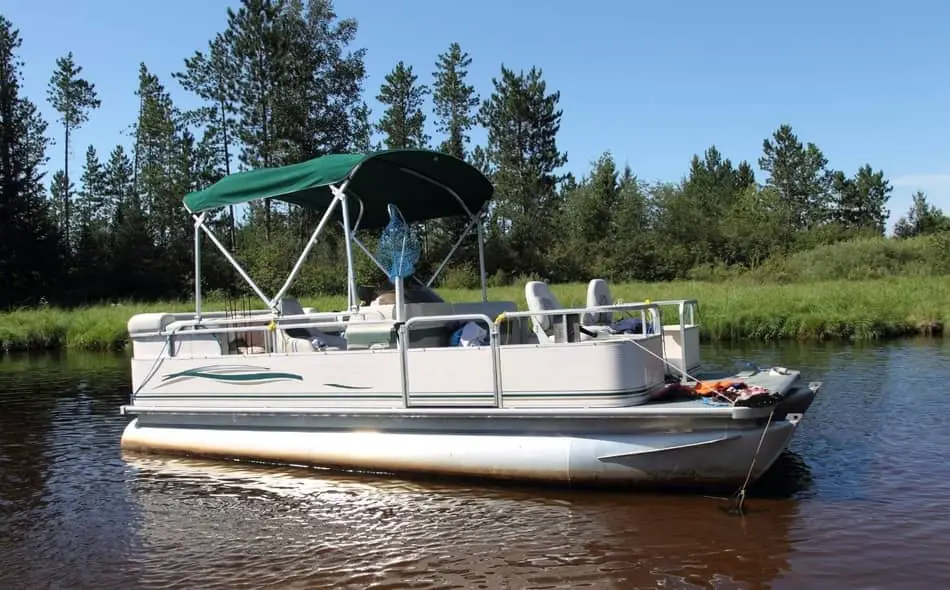
On average, a pontoon boat can hold around 30 gallons of gas in its fuel tank. But the range can vary from 10 gallons or less for a small pontoon to 60 gallons or more for a big pontoon boat. Yet, most brands allow buyers to customize the boat to their needs, worrying less about fuel capacities.
The average pontoon boat will consume around 5 gallons per hour at cruising speed. This means that a five-hour trip out on the water will take 25 gallons of gas.
And it is very common to see a pontoon boat under 20ft with less than a 10-gallon tank. Many pontoon boats come with fuel tanks that are insufficient for the boater’s needs.
Since pontoon boats are not deemed for racing or speed, many manufacturers won’t give bigger tanks. Therefore, many pontoon boat owners replace an existing tank with a bigger one or add a tank to their boat. Here’s a table showing the fuel capacities of different pontoon boat models.
| Pontoon Boat Model | Fuel Capacity |
| Harris LX 160 Cruise | 6.6 Gallons |
| Bennington 188 SVL | 25 Gallons |
| Avalon GS Cruise | 25 Gallons |
| Barletta C24UC | 24 Gallons |
| Manitou 25 Legacy SL | 43 Gallons |
| Bennington 24 R Bowrider | 58 Gallons |
| Starcraft cx 25 dl bar | 60 Gallons |
| Hampton 2680 dc | 25 Gallons |
| Playcraft Infinity 2900 | 30 Gallons |
| Harris Solstice 250 SLEC | 63 Gallons |
Pontoon boats are very popular among the boats. Their simple construction of the deck on two or three pontoon tubes makes it a very special boat. Two pontoons for most of the boats, but three pontoons go under the deck if the boat becomes larger and heavier.
Common pontoon boat designs are a catamaran with two hulls or a trimaran with three hulls. Boats with three hulls are sometimes called tri-toons. Pontoon boats are used for pleasure on lakes and rivers, and in some cases, on oceans close to shore.
Different pontoon boats have different-sized tanks. Most new pontoon boats will have a fuel capacity between 20 and 35 gallons. But most used pontoon boats will not have the same capacity unless the tanks have been upgraded by the current or previous owner (source).
Related Post – Do Boat Use The Same Gas As Car? Check this article to know the difference between the boat and car gasoline in a detailed way.
How Many Gallons Of Gas Does A Bass Boat Hold?
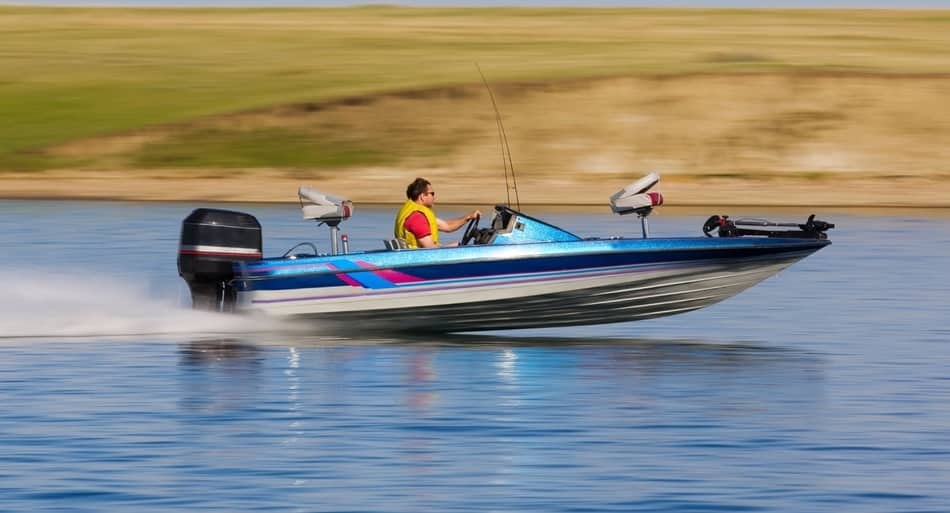
On average, a bass boat can hold around 40 gallons of gas in its fuel tank. But the range can vary from 20 gallons or less for a small bass boat to 70 gallons or more for a big bass boat. Yet, most brands allow buyers to customize the boat to their needs, worrying less about fuel capacities.
A bass boat is a small boat that is designed and equipped primarily for bass fishing or fishing for other panfish, usually in freshwaters such as lakes, rivers, and streams. Unlike some other boats, the bass boat promised a focus on fishing and nothing more.
An average bass boat will consume between 4 – 5 gallons per hour at cruising speed. Each angler is going to have their own preferences and desires for their bass boat. So let’s get into it. Listed here, we have some of the best bass boat models on the market, so let’s see how they compare when stacked up.
| Bass Boat Model | Fuel Capacity |
| Bass Cat Puma FTD SP | 52 Gallons |
| Crestliner 1750 Bass Hawk | 29 Gallons |
| Crestliner PT 20 | 32 Gallons |
| Lund Pro V Bass XS | 39 Gallons |
| Nitro Z21 Pro | 55 Gallons |
| Lund 1875 Crossover XS | 32 Gallons |
| Tracker Pro Team 190 TX | 21 Gallons |
| Skeeter FX21 LE | 48 Gallons |
| Xpress X21 Pro | 40 Gallons |
| Caymas CX 21 | 59 Gallons |
Bass boats are usually propelled by two means: an outboard motor, which moves the boat swiftly from place to place, and a trolling motor, which moves the boat at a slow pace through an area where the angler is fishing, requiring more gas.
Bass boats typically feature aerated livewells, a flat deck, and a powerful outboard engine. The whole idea of this boat is to allow for the best possible fishing experience.
The deck is completely flat, and the form of the boat is very low to the water. This allows for great control of the boat in high wind situations and in shallow waters (which is the ideal place for fishers).
Outdoor Troop
A Bass Cat Puma FTD SP has a 52-gallon fuel tank that allows for easy, stress-free adventure on the water. The maximum horsepower (max HP) of this fishing machine is 250 HP. This means that with this fuel capacity and horsepower capacity, you’ll have the ability to zoom across the water at over 70 mph.
How Many Gallons Of Gas Does A Cabin Cruiser Hold?
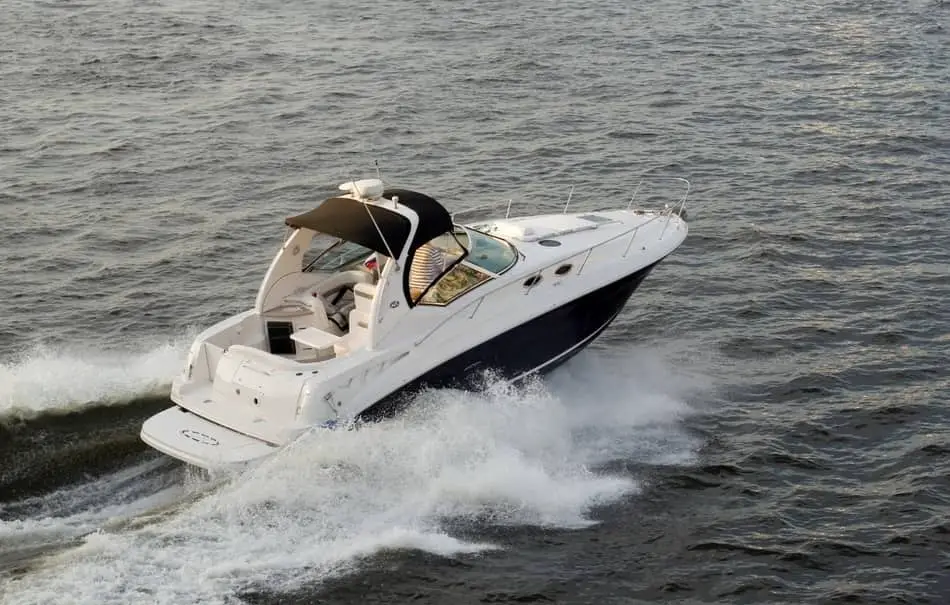
On average, a cabin cruiser boat can hold around 200 gallons of gas in its fuel tank. But the range can vary from 120 gallons or less for a small boat to 500 gallons or more for a big boat. Yet, most brands allow buyers to customize the boat to their needs, worrying less about fuel capacities.
Cabin cruiser boats are just like mobile mini homes that you can use to take the entire family on adventures. Even with small cabin cruisers, you have the flexibility to visit new ports, spend long weekends enjoying the boating lifestyle, or just kick back for a day of swimming and relaxing on the water.
Being bigger in size than most boats (including cuddy cabins), it burns more fuel. So cabin cruiser boats have bigger fuel capacities compared to pontoon boats, bass boats, cuddy cabins, etc. Here’s a table showing the fuel capacities of different cabin cruiser boat models.
| Cabin Cruiser Model | Fuel Capacity |
| Jeanneau Leader 33 | 138 Gallons |
| Regal 33 Express Cruiser | 150 Gallons |
| Chris-Craft 34 Corsair | 185 Gallons |
| Jeanneau NC 1095 Fly | 212 Gallons |
| Back Cove 34O | 185 Gallons |
| Monterey 355SY | 210 Gallons |
| Sea Ray Sundancer 320 | 210 Gallons |
| Sabre 38 Salon Express | 300 Gallons |
| Azimut Magellano 43 | 443 Gallons |
| Intrepid 409 Valor | 450 Gallons |
A cabin cruiser becomes a small yacht if the size increases furthermore, accumulating more space on board. A cabin cruiser also has an area behind the cockpit that is open to the outdoors. This makes a great area for resting in the sun or for fishing, crabbing, and more.
A cabin cruiser will generally range anywhere from $100,000.00 to $500,000.00. Below $100,000, and you’re probably looking at a cuddy cabin and above $500,000.00, and you’re probably looking at a yacht or trawler.
Go Downsize
How Many Gallons Of Gas Does A Cuddy Cabin Hold?
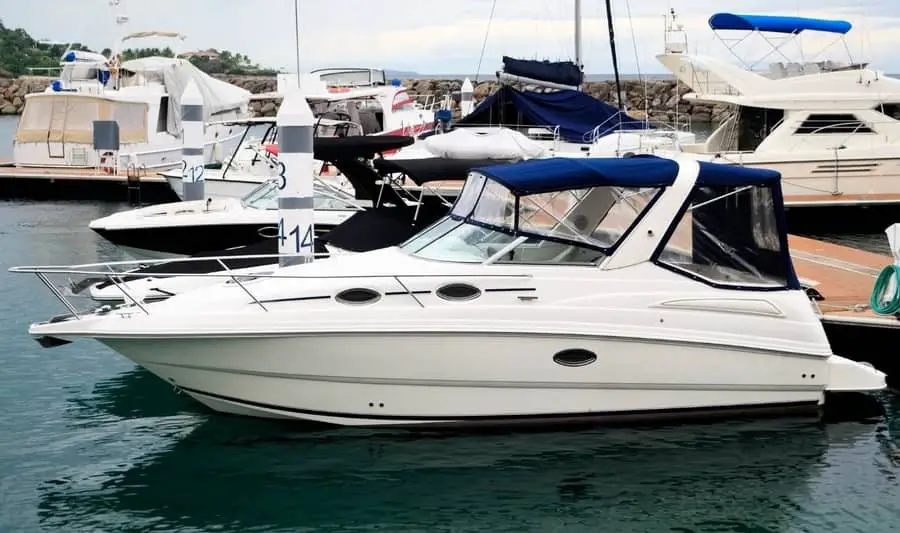
On average, a cuddy cabin boat can hold around 50 gallons of gas in its fuel tank. But the range can vary from 30 gallons or less for a small cuddy to 150 gallons or more for a big cuddy. Yet, most brands allow buyers to customize the boat to their needs, worrying less about fuel capacities.
Cuddy cabin boats offer day cruisers an interior space to sleep at night. These boats are often built like bowrider boats in the center and rear of the boat, but the front holds a cabin rather than a sitting area.
In fact, the average size of a cuddy cabin is between 18 and 28 feet long. Anything larger, and you’re probably dealing with a cabin cruiser rather than a cuddy cabin. Here’s a table showing the fuel capacities of different Cuddy Cabin boat models.
| Cuddy Cabin Model | Fuel Capacity |
| Bayliner VR5 | 33 Gallons |
| Rinker 22MTX | 34 Gallons |
| Rinker 23QX | 41 Gallons |
| Stingray 225cr | 56 Gallons |
| Stingray 250cr | 68 Gallons |
| Crownline 264 cr | 75 Gallons |
| Sea Ray Sundeck | 85 Gallons |
| 22 Sea Hunt 225 Victory | 87 Gallons |
| Rinker 29QX | 75 Gallons |
| 20 Proline Hardtop | 300 Gallons |
Cuddy cabin boats need a lot of fuel depending on the size and the usage. If you are cruising all day and want to sleep overnight, at least a 100-gallon tank is a must. Anything lower than that means you are at risk and should use the fuel accordingly.
Related post – Is Boat Fuel Expensive? Check this article to know more about the cost of the fuel that is used in boats and how they distinguish from normal gas station prices.
How Many Gallons Of Fuel Does A Yacht Hold?
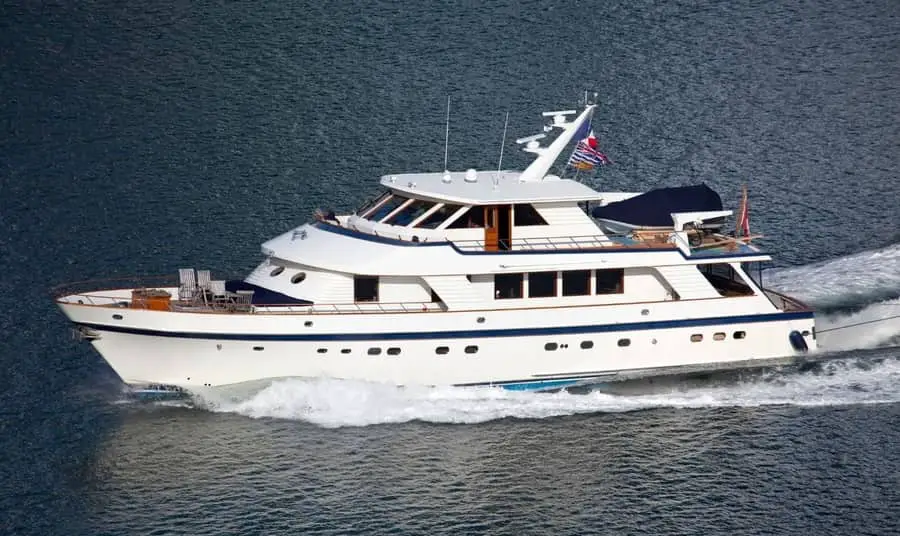
On average, a yacht can hold around 25,000 gallons of fuel in its fuel tank. But the range can vary from 1,000 gallons for a small yacht to 250,000 gallons or more for a big yacht. Yet, most brands allow buyers to customize the yacht accordingly, worrying less about fuel capacities.
A yacht is a larger recreational boat or ship. The word “Yacht” came from Dutch origin and was originally defined as a light and fast sailing vessel used by the Dutch navy to find and capture pirates. On the other hand, a boat is smaller in size and can be anything from a fisherman’s boat to a sailboat.
Yacht engines are much larger in size, can produce considerably more power – in some cases up to 800hp, and are capable of running much longer distances, requiring very bigger tanks. Here’s a table showing the fuel capacities of different yacht models.
| Yacht Model | Fuel Capacity |
| Lexus LY 650 | 1000 Gallons |
| Canova Sailing Superyacht | 3000 Gallons |
| Tatiana Yacht | 40,946 Gallons |
| Attila Yacht | 42,267 Gallons |
| Soaring Yacht | 53,626 Gallons |
| LANA Yacht | 79,251 Gallons |
| O’Pari yacht | 86,363 Gallons |
| Flying Fox Yacht | 180,297 Gallons |
| Azzam Yacht | 264,172 Gallons |
| Dilbar Yacht | 277,301 Gallons |
Smaller yachts like motor yachts or motor sails can hold around 3,000ish gallons of fuel, while the larger ones have the capacity for up to 250,000 gallons. That could cost $875,000 to fill up the tank with an average fuel price of $3.50 per gallon. Imagine spending close to $1,000,000 to fill up the yacht.
According to Superyachts.com, a boat measuring more than 71 meters consumes a staggering 132 gallons of diesel an hour—and that’s only if the engine is on, but the boat isn’t moving. If you actually want to go anywhere, you will be spending over $2,440 an hour, based on cruising speeds of between 15 and 22 knots.
Lürssen’s M/Y Azzam currently holds the title of the largest superyacht in the world. That’s equivalent to refilling a typical hatchback car more than 23,800 times, and the same amount of fuel could fill up almost six Boeing 747 commercial airliners. Likewise, it would take the fuel of 3,636 London double-decker buses or 167 24-meter yachts to fill Azzam.
The Key Takeaways From The Post
A boat can hold around 40 gallons of gas in its tank on average. But the range can vary from 5 gallons or less for a small boat to 250,000 gallons or more for a big yacht. Yet, most brands allow buyers to customize the boat to their needs, worrying less about fuel capacities.
Boats are not as fuel-efficient as cars. They consume a lot of gas compared to other vehicles due to traversing in the waters. That’s one of the main reasons why most boats have bigger fuel capacities compared to other vehicles.
Many small boats tend to use 3-8 gallons of gas per hour at cruising speeds, while faster boats like speed and motorboats can use 25-40 gallons an hour.
Depending on the boat’s weight, size, model, and, very importantly, the type of motor it has, the fuel burning rate changes drastically.
